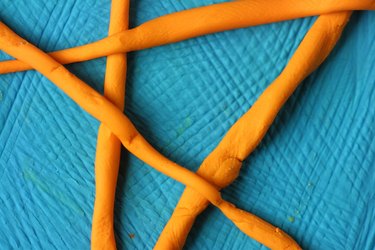Things You'll Need
Parchment paper
Hairdryer
Thin blade or knife
Liquid clay softener
Petroleum jelly
Reclosable bag

Rather than tossing out stiff modeling clay, you can restore its plasticity with a few tricks. A heat-treatment method with the hair dryer is quite effective at softening polymer. Other options include working additives into the clay to restore moisture. You may want to start with the simplest option and move on to more complicated techniques.
Using Heat to Soften Clay
Step 1
Tape a piece of parchment paper to your work surface. Place the hardened piece of clay on top of it.
Video of the Day
Step 2
Turn on the hair dryer. Set it to the high heat setting.
Step 3
Apply heat to the hardened clay until it is visibly softened. Turn off dryer. Check that the clay has softened enough to work with. If it has not, keep using the dryer until the clay softens.
Using Additives to Soften Clay
Step 1
Chop the hardened clay up into small pieces with the knife blade.
Step 2
Use a liquid clay softener to soften the clay pieces. Follow the instructions on the package of the liquid clay softener for best results. Otherwise, massage between two to five drops of the softener into the clay. If it is still too hard to work with, apply two more drops of clay softener. Place in reclosable plastic baggy and let sit while the clay softener is absorbed.
Step 3
Use a small amount petroleum jelly -- less than half a teaspoon -- instead of the liquid clay softener. Work the jelly into the clay pieces until they soften up.
Tip
Consider mixing fresh translucent clay in with a difficult-to-work clay. By using translucent clay, which is usually much softer than opaque, you can still preserve the color.
Warning
Working additives into clay can alter its chemistry, potentially affecting how long it takes to bake.
The additive-worked clay may also leave a residue on your skin.
Video of the Day